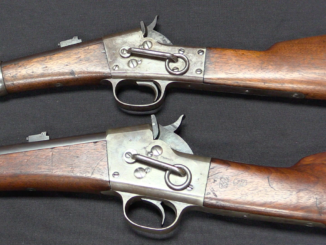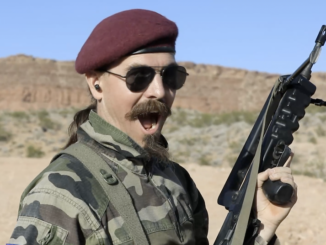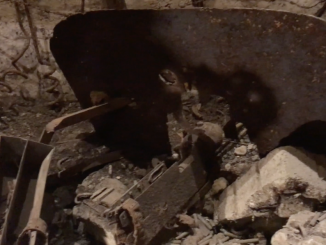At the end of World War Two, the Paris Police decided that they needed a few different features on a police submachine gun than the then-standard MAS 38 offered. A few hundred were converted to the new police requirements, interestingly mirroring the characteristics that would be used a few years later when the military adopted the MAT 49 to replace the MAS 38. These changes include a barrel shroud, collapsing wire stock, and a folding magazine well. In addition, a selector lever was added to allow semiautomatic fire (the original MAS 38 was full auto only).
Thanks to the French Ministry of the Interior for providing me access to this MAS 38 to bring to you!




i couldn’t even imagine what a proper mag for that would go for.
The MAS 38 was already fairly small as full-bore SMGs go. The police version moves it even closer to what might be called a true “machine pistol”, much as the slightly later MAT 49 did.
To see what I mean, compare this version of the MAS 38 or an MAT 49 side-by-side with a Mauser 712 Schnellfeuer or any of its Spanish clones such as the Royal. Then compare the French SMGs to a more orthodox SMG of the M# pattern, such as, well, an M3 “Grease Gun”.
The MAS 38 and MAT 49 are distinctly closer in size to the machine pistols than to the “full-grown” SMG.
I can’t help but think that they would be easier to manage getting in and out of a cruiser than a “regular” SMG. Or even a police type shotgun.
The modified MAS 38 seems to me to be particularly suitable for stakeout duty. It could easily be concealed under the long coats popular in Europe at that time.
In fact, a loop of belting around that crossbar in the buttstock’s “buttplate” would allow it to be hung muzzle-down under your armpit.
Just reach across to press the button to extend the stock and lock it, then sawing the magazine into place and lock it. Assuming you already had the bolt cocked, all you need to do is flip it up, grab the pistol grip, and it’s “Police! Arrête ou je tire!” time.
cheers
eon
The last line sounds like better contextual conjugation could be used. The stop command should be issued with a reflexive object pronoun in a more generic or plural/formal manner, unless my French grammar and terminology need improvements. That aside, good ideas about carrying in the car. As long as we don’t confuse regular cops with the Gendarmerie, we’re good. Then again, what do the latter issue, big irons? Just kidding!
“Arrête ou je tire !” is correct, but it sounds a bit thug-ish, as police officer shouldn’t use “tutoiement” (because it doesn’t help with deescalation, although to be fair, we might be past it if guns are drawn).
There is indeed a difference between “Arrête toi/Arrêtez vous” and “Arrête/Arrêtez”, the former being used mostly regarding movement (as in “stop running”, “stop here, we’re going to get baguettes in that bakery”) and the latter being used in any other situation (“stop fighting”, “stop bothering your brother”, etc.), but either will be understood.
Don’t blame me, blame Google Translate.
cheers
eon
Hmm… collapsible stocking and folding magazine? This reminded me about ТКБ-486 designed in 1950s specifically for undercover carry, see photos: http://zonwar.ru/pp/TKB-486.html
9×18 mm cartridge, empty mass 1,3 kg, Rate-of-Fire 550 rpm, overall length 612 mm (stock extended) and 380 mm (stock folded)
I like it! Never seen that before, thanks.
”The modified MAS 38 seems to me to be particularly suitable for stakeout duty. It could easily be concealed under the long coats popular in Europe at that time. ”
More under the short cape as they weared them until the 60s IIRC. Wiht that type of cape it was even better as concealed weapon and could explain many of the changes to shorten it:
http://www.amicale-police-patrimoine.fr/Medias/catalogue%20Uniformes/061%20Uniforme%20agent%20de%20police%20SG%20SN%20Hiver%201947-1966.jpg
I’m gonna guess that some of these were carried in motorcycle or motorbike storage. The Paris Prefecture Police still use motorcycles and I bet right after WW2 there more common: https://www.youtube.com/watch?v=_kZukBziKac
Preloading the recoil spring by limiting its travel increases the firing pin strike on the primer. Also compressing the spring increases the force required to get the bolt moving rearward. The impulse from the fired case is resisted by the mass of the bolt plus the spring. Unless the spring steel was sub standard, a guy could simulate the PP variant with a plug in the regular buttstock. I don’t own one and wouldn’t want to be responsible if some tinkerer were to try it. 🙂
I’m curious, does the standard magazine fit the Police Model with the magazine well flipped forward and out of the way. It looks otherwise unmodified.
Ian’s lessons in French have apparently paid off handsomely. That the French Ministry of the Interior would provide him access to those guns, well, congratulations !
I would expect French government access long before U. S., British, or German. I have found French people
to be uniformly welcoming to anyone with a genuine interest in a subject or activity.
The MAS series of SMGs typically French ‘tailored’ / specials. With a number of advantages, but also somewhat odd. It is significant that the Germans made little use of them WW2 (though this in part due to their ‘non standard’ ammunition) and nobody followed their pattern – though the French appeared fully satisfied with and enthusiasts for them (as indicated by their long service life with them and reluctance to give them up).
Folding magazine seems to be a thing for French fire-arms designer, starting even before WWII, as it was implemented in Pistolet Mitrailleur Modèle 1939
https://guns.fandom.com/wiki/Petter_Mle_1939
it has also detachable stock (see photo) and if data provided are correct – it used different magazine than MAS 38 – as it has capacity 36 as opposed to 32.
In immediate post-war era HOTCHKISS produced sub-machine gun, which might be called ultimately collapsible sub-machine gun called HOTCHKISS UNIVERSAL
https://modernfirearms.net/en/submachine-guns/france-submachine-guns/hotchkiss-universal-eng/
I am not big fan of this gun. If I had to characterise it I’d say: from less than tidy – to really untidy. Take a look at that disproportional grip for one. Whole thing is kind of sweated-out. Not impressed.
That being written is not suppose to touch on Ian’s performance which is no less than phenomenal, as always.
Design of original, that is M.A.S. 1938 with spring occupying serious part of stock, see drawing:
https://commons.wikimedia.org/wiki/File:MAS38sheme.jpg
suggest that designer was not concerning with providing good start point for “minimalization”, which is totally understandable taking in account M.A.S. 1938 was already quite small when compared to other sub-machine guns of that era, partially thank to this solution.
Please compare this to AR-15 derived “automatic pistol” which need to overcome similar problem – crucial mechanism part in tube behind.
It’s strange that Ian did not take it apart. Usually he is not afraid of this…
And the fire selector should not interfere with disassembly. The French, of course, sometimes, are rather strange…
But they are NOT idiots.
Perhaps it should just find the desired position of the selector?
Perhaps the device is malfunctioning?
If the impossibility of field disassembly has not been specifically done…
Moreover, Ian said “there is no manual trigger safe”, but the necessary recesses on the trigger and lower are present…
Dismantling would be all the more interesting, because a main spring of a smaller diameter can be used there than on a conventional MAS38.
Otherwise, I don’t understand where they shared this spring?..